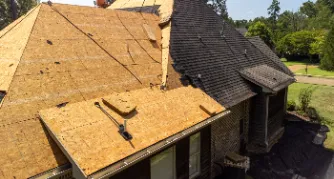When it comes to protecting your home from the elements, most homeowners think about shingles, gutters, and other visible roofing components. However, beneath those materials lies one of the most critical—and often overlooked—elements of your roofing system: roof decking.
As your trusted Charleston, SC roofing experts at Big Bear Roofing, we’ve seen firsthand how proper roof decking can mean the difference between a roof that lasts for decades and one that fails prematurely.
What Is Roof Decking, and Why Does It Matter?
Roof decking, also known as roof sheathing, is the structural layer that sits directly on top of your home’s rafters or trusses. It provides the flat surface upon which all other roofing materials—such as underlayment and shingles—are installed.
In the Carolinas, where high humidity, heavy storms, and temperature swings are common, your roof decking must be strong, stable, and moisture-resistant. Without it, your roof simply can’t withstand the environmental challenges our region presents.
The Carolina Climate Challenge: Why Roof Decking Matters More Here
High Humidity and Its Effects
Persistent moisture causes roofing materials to expand and contract, which over time stresses the decking. Humidity can also promote mold, mildew, and rot, especially if poor ventilation or damaged shingles allow moisture to reach the decking.
Storm Damage and Structural Integrity
From hurricanes to high winds, Carolina weather puts decking to the test. Poorly installed or weakened decking can compromise your entire roof’s structural integrity, making it more vulnerable during extreme weather events.
Common Roof Decking Materials
Plywood
Known for its density and moisture resistance, plywood performs well in humid coastal environments. It helps reduce warping and rot, making it ideal for homes in Charleston, Raleigh, and Greensboro.
Oriented Strand Board (OSB)
OSB is a cost-effective, water-resistant alternative to plywood. While suitable for many climates, it’s less durable in high-humidity environments and may swell or delaminate over time.
Plank Decking
Often found in older homes, plank decking is structurally sound but more prone to gaps and less effective at resisting moisture. It also requires more labor during repairs or upgrades.
Warning Signs: When Your Roof Decking Needs Attention
-
Sagging Rooflines – A sign of lost structural integrity
-
Interior Water Stains – Indicates water infiltration past shingles
-
Soft or Spongy Spots – Suggests moisture damage or rot
-
Visible Daylight from the Attic – A severe structural issue needing immediate attention
Professional Roof Decking Installation: The Big Bear Roofing Difference
Our Step-by-Step Process
We begin with a comprehensive inspection, evaluate attic ventilation, level the surface, and install the decking using approved fasteners and spacing techniques to ensure durability.
Premium Materials & Expert Craftsmanship
We use premium-grade plywood or OSB and always include a moisture-resistant underlayment for added protection and insulation.
Maintenance Tips: Extending the Life of Your Roof Decking
Schedule Annual Inspections
Our team performs in-depth inspections of both exterior roofing and attic conditions to identify hidden issues early.
Ensure Proper Attic Ventilation
Systems like ridge vents, soffit vents, and gable vents help regulate attic temperature and humidity, reducing the risk of moisture buildup.
Make Prompt Repairs
Prompt roof repair for minor leaks or flashing damage can prevent more serious structural issues or decking rot.
Roof Decking & Energy Efficiency
Improved Thermal Performance
Proper roof decking supports insulation, prevents thermal bridging, and helps maintain comfortable indoor temperatures, thereby lowering energy bills.
Moisture Control and Air Quality
Preventing water intrusion not only protects your structure but also improves indoor air quality by reducing the risk of mold growth.
Why Investing in Quality Roof Decking Pays Off
Extended Roof Lifespan
A well-installed deck can extend your roof’s life to 25–30 years, reducing long-term costs and future headaches.
Lower Repair Costs
Quality decking prevents water damage to your insulation, drywall, and personal belongings.
Increased Home Value
A solid roofing system—especially one backed by warranties—adds to your home’s resale value.
Storm Damage and Insurance Considerations
Proper Installation Supports Insurance Claims
When damage occurs, your claim is more likely to be approved if your decking was installed properly and documented by a licensed professional like Big Bear Roofing.
Building Code Compliance & Wind Resistance
We follow up-to-date building codes to ensure your decking meets or exceeds wind resistance requirements—especially important in storm-prone areas.
Why DIY Roof Decking Is Risky
Safety Hazards
Roofing work is dangerous. Our licensed team has the training and equipment needed to do the job safely.
Technical Complexity
Installing roof decking properly requires an experienced roofing contractor who understands building codes, structural load, and ventilation principles—this is not a DIY weekend project.
Warranty Protection
Our work includes labor and material warranties—something DIY projects can’t offer.
Conclusion: Protect Your Carolina Home with Quality Roof Decking
Roof decking may not be visible, but it’s one of the most important parts of your roofing system. In the Carolinas’ humid, storm-prone climate, investing in high-quality materials and professional installation is essential.
At Big Bear Roofing, our certified professionals know what it takes to build durable, energy-efficient roofs that stand the test of time. Whether you’re replacing a roof or just need an inspection, we’re here to help you protect your home—and your peace of mind.
Ready for a strong, secure roof?
Contact Big Bear Roofing today for a free roof decking inspection and consultation. Let’s ensure your roof has the reliable foundation it needs to keep your family and home safe.

